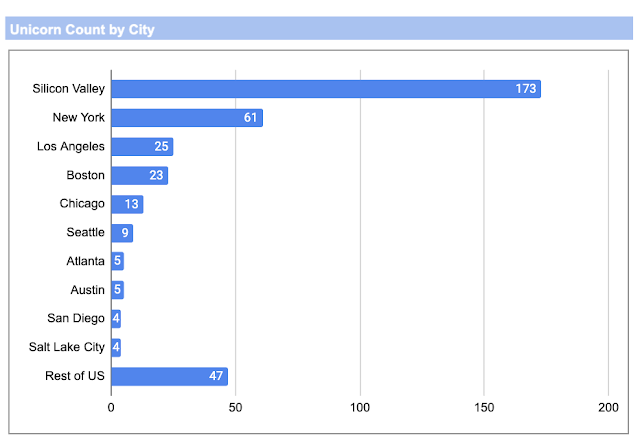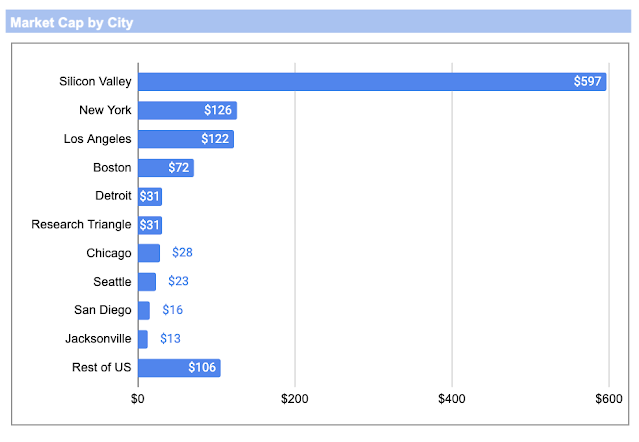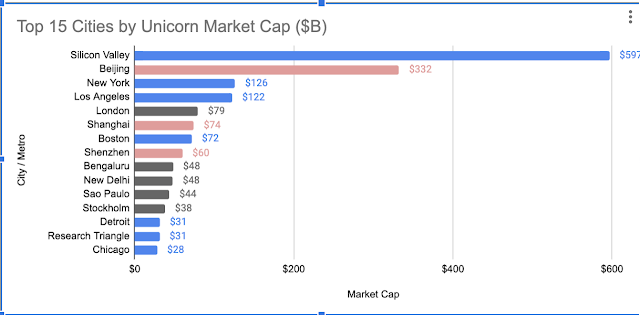
1. A little tweetstorm on the post-COVID geography of startups & tech hubs. This is from a post by @eladgil: blog.eladgil.com/2021/06/unicor…
2. Gil tracks the geography of new unicorn companies - defined as those with more than a $1 billion market cap - since October 2020. The data are from @CBinsights cbinsights.com/research-unico…
and he supplies his raw data here: docs.google.com/spreadsheets/d…
and he supplies his raw data here: docs.google.com/spreadsheets/d…
3. Let me add the caveat, as Gil does, that such data are updated over time, so very recent unicorns may not be included, and also than unicorns - given the size and stature - are a retrospective measure of which likely underplay emerging hubs.
4. Nonetheless the data are striking and suggest LITTLE change in the geography of leading tech hubs up until now.
6. The San Francisco Bay Area leads with a whopping 69 of 227 all new unicorns - 30% of those created in the last 8 months. Yowza.
7. In second place, eh hem, NYC, with 30. No other city breaks into double digits ...
8. Then we have London and LA with 8 each.
Chicago, Tel Aviv & Bengaluru with 7 each.
Boston with 6.
Paris & Berlin 5.
TORONTO with 4.
And, Seattle, AUSTIN, DC & Philly with 3 each.
Chicago, Tel Aviv & Bengaluru with 7 each.
Boston with 6.
Paris & Berlin 5.
TORONTO with 4.
And, Seattle, AUSTIN, DC & Philly with 3 each.
9. Interesting that of the much ballyhooed rising tech hubs, Miami does not make the list, & Austin logs in with just 3. Though that of course may change in coming years as the new investment in these hubs develops.
10. Even more interesting is the absence of Chinese cities - especially Shanghai & Beijing on this list.
11. Europe looks to have several significant tech hubs - London, Paris, Berlin.
13.The list changes somewhat.
But the Bay Area remains on top.
NYC is now 3rd & London 4th.
Chinese cites move up the list: Beijing is 2nd, Shanghai 5th & Shenzen 8th.
Of US cities: Boston is 7th, Detroit & the Research Triangle tie for 13th & Chicago 15th.
No Austin or Miami.
But the Bay Area remains on top.
NYC is now 3rd & London 4th.
Chinese cites move up the list: Beijing is 2nd, Shanghai 5th & Shenzen 8th.
Of US cities: Boston is 7th, Detroit & the Research Triangle tie for 13th & Chicago 15th.
No Austin or Miami.
14. This is the unicorn count for US cities. Again, strikingly familiar. Biggest take away for me is the position of NYC & LA in 2nd and 3rd behind the Bay Area. 

15. This is the ranking by unicorn market cap for US cities. Note two things: Detroit in 5th place, and Jacksonville in 10th. 

16. Now again, unicorns are a retrospective-looking metric. Things are likely to change. But right now the geography looks more stable than shifting.
17. My own take on this is that the geography of innovation, startups & tech hubs is much more stable than we think. it will remain quite spiky & concentrated.
18. What is most likely to change is the positioning of 2nd and 3rd tier hub - that is the most likely place we are likely to see movement, with new hubs emerging & older hubs fading.
19. Again, the original post & analysis is by @eladgil. And the post is here: blog.eladgil.com/2021/06/unicor…
Someone should do similar for ANGEL INVESTING.
Someone should do similar for ANGEL INVESTING.
• • •
Missing some Tweet in this thread? You can try to
force a refresh





